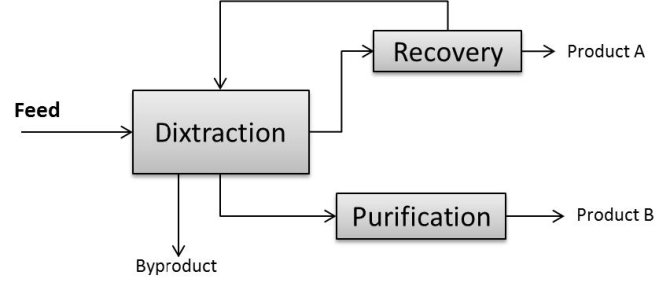
Projet
Integrated biorefineries AlgaePro4U: Extraction and fractionation of functional proteins from microalgae
Algae shows a remarkable potential as source of biomolecules with application in many industries. However, in order to make feasible its commercial application, competitive biorefining strategies must be developed in a framework of mild operation and integration of unit operations, targeting proteins, carbohydrates and lipids.
Introduction
Microalgae have been considered as a potential and sustainable source of biomolecules with application in several industries (Vanthoor-koopmans et al., 2012). In addition to oils and sugars for the production of biofuels, proteins –which can reach 70% by weight in algae- can be used for the preparation of feed and foods and/or as supplementary ingredients (Becker, 2007). Several investigations have suggested that proteins recovered from algae display comparable or superior functionality (foaming, emulsification, surfactant, solubility, gelation) as other commercial protein preparations (Schwenzfeier et al., 2013). However, in order to realize the application of algae proteins for food or feed, mild processing conditions must be ensured and the protein fractions must be free from unwanted contaminants that cause off-properties. In addition, the biorefinery strategy must ensure the profitability of the process. A recent publication indicated that up to 80% of the costs of biorefining -downstream processing- of algae is due to the first step of the separation train (extraction of purification of the main target component) (Ruiz Gonzalez et al., 2016). In this regard, several strategies can be implemented in order to ensure cost reduction:
- Valorizing several -if not all- biomolecules with market potential.
- Targeting high end market applications (pharmaceutical, cosmetics, foods, feeds).
- Intensifying and integrating unit operations (Eggersgluess et al., 2014).
- Implementing recycling and reuse strategies to ensure low operational costs.
The first step in most algae biorefinery applications involves the disintegration (disruption) of the biomass in order to release components into the liquid phase. Several investigations performed in our group identified bead milling as a highly efficient disruption method (Postma et al., 2015). In recent years, Ionic Liquids (IL) have been considered as novel “green” solvents with potential application for the fractionation and purification of biomolecules (Freire et al., 2012). Consequently, it is suggested that IL can be implemented as green solvents for the extraction of proteins from algae. Furthermore, the extraction can be performed simultaneously with the disruption step – Dixtraction- as described in figure 1:

Aim
Investigate the implementation of bead milling and Ionic Liquids in a biorefinery framework for the extraction of proteins and other biomolecules with application in food and feed. In addition, evaluate strategies for the development of scalable mild isolation and fractionation processes.
Approach
The project will be executed in a period of four years, I accordance to the following main activities:

Partners and/or acknowledgments
This project is financed by STW (project 12535).
References
Becker, E.W., 2007. Micro-algae as a source of protein. Biotechnol. Adv. 25, 207–210.
Eggersgluess, J., Wellsandt, T., Strube, J., 2014. Integration of aqueous two-phase extraction into downstream processing. Chem. Eng. Technol. 37, 1686–1696.
Freire, M.G., Cláudio, A.F.M., Araújo, J.M.M., Coutinho, J. a. P., Marrucho, I.M., Lopes, J.N.C., Rebelo, L.P.N., 2012. Aqueous biphasic systems: a boost brought about by using ionic liquids. Chem. Soc. Rev. 41, 4966.
Postma, P.R., Miron, T.L., Olivieri, G., Barbosa, M.J., Wijffels, R.H., Eppink, M.H.M., 2015. Mild disintegration of the green microalgae Chlorella vulgaris using bead milling. Bioresour. Technol. 184, 297–304.
Ruiz Gonzalez, J., Olivieri, G., de Vree, J., Bosma, R., Willems, P., Reith, H., Eppink, M., Kleinegris, D.M.M., Wijffels, R.H., Barbosa, M., 2016. Towards industrial products from microalgae. Energy Environ. Sci.
Schwenzfeier, A., Lech, F., Wierenga, P.A., Eppink, M.H.M., Gruppen, H., 2013. Foam properties of algae soluble protein isolate: Effect of pH and ionic strength. Food Hydrocoll. 33, 111–117.
Vanthoor-koopmans, M., Wijffels, R.H., Barbosa, M.J., Eppink, M.H.M., 2012. Bioresource Technology Biorefinery of microalgae for food and fuel. Bioresour. Technol. 135, 142–149.